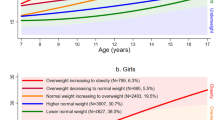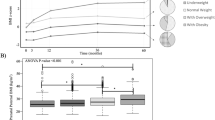Abstract
Objective:
To determine if the sex of the participating parent/child pair is a contributing factor in initial weight loss and maintenance within a family-based obesity treatment program.
Design:
A 2-year family-based obesity treatment program targeting one overweight parent and one overweight child.
Subjects:
One overweight parent (body mass index (BMI)⩾25) and child (⩾85th BMI percentile) from 164 families.
Measurements:
Parameters of body weight, including height, weight, BMI, z-BMI, percent overweight (BOV) at baseline and at 6-, 12- and 24-month follow-up time points.
Results:
Children within the opposite-sex dyads had greater weight loss (P<0.01) at 6- and 12-month time points compared with children in the same-sex dyads. Parents within opposite-sex dyads had significantly greater weight loss at 24 months (P<0.05) compared with those in the same-sex dyads. When individual dyads were examined, the change in child z-BMI after 6 months was greater for the mother–son dyad as compared to the mother–daughter and father–son (P<0.05). For parent z-BMI, the mother–daughter dyad consistently exhibited the poorest results. At 6- and 12-month time points, parents in the mother–daughter dyad lost significantly less weight than parents in all other dyads (P<0.05), and at 24 months, parents in the mother–daughter dyad lost less weight than parents in the opposite-sex dyads (P<0.05).
Conclusion:
These data reveal that child–parent sex interactions can strongly influence the outcome of obesity treatment when both parent and child are the target for weight loss. The reasons that underlie this effect remain to be determined.
This is a preview of subscription content, access via your institution
Access options
Subscribe to this journal
Receive 12 print issues and online access
$259.00 per year
only $21.58 per issue
Buy this article
- Purchase on SpringerLink
- Instant access to full article PDF
Prices may be subject to local taxes which are calculated during checkout

Similar content being viewed by others
References
Garn SM, Clark DC . Trends in fatness and the origins of obesity Ad Hoc Committee to Review the Ten-State Nutrition Survey. Pediatrics 1976; 57: 443–456.
Garn SM, Sullivan TV, Hawthorne VM . Fatness and obesity of the parents of obese individuals. Am J Clin Nutr 1989; 50: 1308–1313.
Whitaker RC, Wright JA, Pepe MS, Seidel KD, Dietz WH . Predicting obesity in young adulthood from childhood and parental obesity. N Engl J Med 1997; 337: 869–873.
Fogelholm M, Nuutinen O, Pasanen M, Myohanen E, Saatela T . Parent–child relationship of physical activity patterns and obesity. Int J Obes Relat Metab Disord 1999; 23: 1262–1268.
Epstein LH, Myers MD, Raynor HA, Saelens BE . Treatment of pediatric obesity. Pediatrics 1998; 101: 554–570.
Israel AC, Solotar LC, Zimand E . An investigation of two parental involvement roles in the treatment of obese children. Int J Eat Disord 1989; 9: 557–564.
Brownell KD, Kelman JH, Stunkard AJ . Treatment of obese children with and without their mothers: changes in weight and blood pressure. Pediatrics 1983; 71: 515–523.
Epstein LH, McCurley J, Wing RR, Valoski A . Five-year follow-up of family-based behavioral treatments for childhood obesity. J Consult Clin Psychol 1990; 58: 661–664.
Golan M, Weizman A, Apter A, Fainaru M . Parents as the exclusive agents of change in the treatment of childhood obesity. Am J Clin Nutr 1998; 67: 1130–1135.
Epstein LH, Wing RR, Steranchak L, Dickson B, Michelson J . Comparison of family-based behavior modification and nutrition education for childhood obesity. J Pediatr Psychol 1980; 5: 25–36.
Kalakanis LE, Goldfield GS, Paluch RA, Epstein LH . Parental activity as a determinant of activity level and patterns of activity in obese children. Res Q Exerc Sport 2001; 72: 202–209.
Wrotniak BH, Epstein LH, Paluch RA, Roemmich JN . Parent weight change as a predictor of child weight change in family-based behavioral obesity treatment. Arch Pediatr Adolesc Med 2004; 158: 342–347.
Epstein LH, Valoski AM, Wing RR, McCurley J . Ten year outcomes of behavioral family-based treatment for childhood obesity. Health Psychol 1994; 13: 373–383.
Epstein LH, Paluch RA, Raynor HA . Sex differences in obese children and siblings in family-based obesity treatment. Obes Res 2001; 9: 746–753.
Ogden J, Steward J . The role of the mother–daughter relationship in explaining weight concern. Int J Eat Disord 2000; 28: 78–83.
Edmunds H, Hill AJ . Dieting and the family context of eating in young adolescent children. Int J Eat Disord 1999; 25: 435–440.
Cutting TM, Fisher JO, Grimm-Thomas K, Birch LL . Like mother, like daughter: familial patterns of overweight are mediated by mothers’ dietary disinhibition. Am J Clin Nutr 1999; 69: 608–613.
Wrotniak BH, Epstein LH, Paluch RA, Roemmich JN . The relationship between parent and child self-reported adherence and weight loss. Obes Res 2005; 13: 1089–1096.
Bussey KBA . Influence of gender consistancy and social power on sex-linked modeling. J Pers Soc Psychiatr 1984; 47: 1292–1302.
Bussey K, Perry DG . Same-sex imitation: The avoidance of cross-sex models or the acceptance of same-sex models? Sex Roles 1982; 8: 773–784.
US Department of Health and Human Service (DHHS). National Center for Health Statistics. National Health and Nutrition Examination Survey, III 1988–1994, NHANES III Laboratory Data File (CD-ROM). Centers for Disease Control and Prevention: Hyattsville, MD, 1996.
Epstein LH, Paluch RA, Gordy CC, Dorn J . Decreasing sedentary behaviors in treating pediatric obesity. Arch Pediatr Adolesc Med 2000; 154: 220–226.
Epstein LH, Paluch RA, Gordy CC, Saelens BE, Ernst MM . Problem solving in the treatment of childhood obesity. J Consult Clin Psychol 2000; 68: 717–721.
Epstein LH, Paluch RA, Kilanowski CK, Raynor HA . The effect of reinforcement or stimulus control to reduce sedentary behavior in the treatment of pediatric obesity. Health Psychol 2004; 23: 371–380.
Kuczmarski R, Ogden C, Guo S, Grummer-Strawn L, Flegal K, Mei Z et al. 2000 CDC growth charts for the United States: methods and development. Vital Health Stat 2002; 11: 1–190.
Systat Software. Systat 10.2. SYSTAT Software Inc.: Richmond, CA, 2002.
Bellisle F, Dalix AM, Slama G . Non food-related environmental stimuli induce increased meal intake in healthy women: comparison of television viewing versus listening to a recorded story in laboratory settings. Appetite 2004; 43: 175–180.
Hood MY, Moore LL, Sundarajan-Ramamurti A, Singer M, Cupples LA, Ellison RC . Parental eating attitudes and the development of obesity in children. The Framingham Children's Study. Int J Obes Relat Metab Disord 2000; 24: 1319–1325.
Klesges RC, Coates TJ, Brown G, Sturgeon-Tillisch J, Moldenhauler-Klesges LM, Holzer B et al. Parental influences on children's eating behavior and relative weight. J Appl Behav Anal 1983; 16: 371–378.
Nuutinen O, Knip M . Predictors of weight reduction in obese children. Eur J Clin Nutr 1992; 46: 785–794.
Davison KK, Birch LL . Child and parent characteristics as predictors of change in girls’ body mass index. Int J Obes Relat Metab Disord 2001; 25: 1834–1842.
Fisher JO, Birch LL . Restricting access to palatable foods affects children's behavioral response, food selection, and intake. Am J Clin Nutr 1999; 69: 1264–1272.
Tiggemann M, Lowes J . Predictors of maternal control over children's eating behaviour. Appetite 2002; 39: 1–7.
Elfhag K, Linne Y . Gender differences in associations of eating pathology between mothers and their adolescent offspring. Obes Res 2005; 13: 1070–1076.
Acknowledgements
This research was supported by Grants HD 25997 and HD 20829 from the National Institute of Child Health and Human Development (LHE).
Author information
Authors and Affiliations
Corresponding author
Rights and permissions
About this article
Cite this article
Temple, J., Wrotniak, B., Paluch, R. et al. Relationship between sex of parent and child on weight loss and maintenance in a family-based obesity treatment program. Int J Obes 30, 1260–1264 (2006). https://doi.org/10.1038/sj.ijo.0803256
Received:
Revised:
Accepted:
Published:
Issue date:
DOI: https://doi.org/10.1038/sj.ijo.0803256
Keywords
This article is cited by
-
Meta-synthesis of qualitative studies to explore fathers’ perspectives of their influence on children’s obesity-related health behaviors
BMC Nursing (2024)
-
Influence of Parenting Styles on Willingness to Use Marijuana among Rural and Urban Costa Rican Adolescents
Journal of Child and Family Studies (2023)
-
Parents as Agents of Change (PAC) in pediatric weight management: The protocol for the PAC randomized clinical trial
BMC Pediatrics (2012)
-
Parenting Characteristics in the Home Environment and Adolescent Overweight: A Latent Class Analysis
Obesity (2010)
-
Overgewicht en obesitas bij kinderen: werken we met de ouder, met het kind of met ouder én kind?
Kind adolescent praktijk (2009)



